
 |
|
|
Colors of The Tennessee
Walking Horse |
|

|
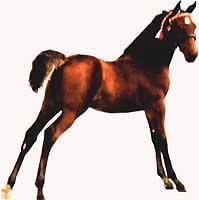 |
BAY |
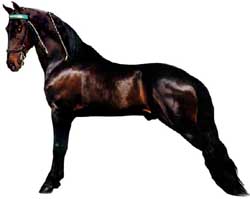 |
| Bay
horses, with a base color coat that ranges from light to dark,
reddish brown hues, are distinguished by black mane and tail, legs,
ears, knees, hocks, or any combination of these points. Bays
also may have white markings on the legs and face. A resemblance of
blacks to chestnuts may be ascertained by the presence of black
points above the white leg markings. |
|
|
 |
| SORREL
|
Some breed
registries of horses in the same general color diversifications
as the Tennessee Walking Horses do not include the sorrel horse.
They are called "light chestnuts" in some of the other breeds, but
the stud books
and registry of the TWHBEA includes thousands of horses identified
as sorrels.
|
|
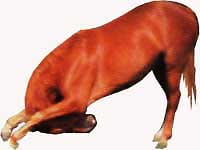 |
| These horses range
in color from a light, golden base color, often with flaxen or light
blonde manes and tails, to a darker golden red, also often
with light manes and tails. In the lighter colors, the sorrel
is often confused with palomino, which along with the sorrel is a
dilution of the chestnut heritage. According to
geneticists, both chestnut and sorrel matings breed true,
i.e., chestnuts bred to chestnuts produce chestnuts and sorrels
mated to sorrels produce sorrel foals. |
|
|

|
|
PALOMINO |
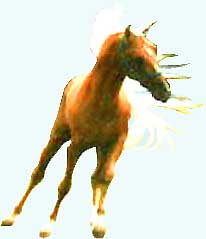 |
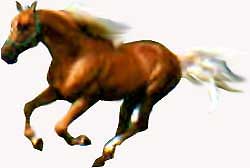 |
| Palomino horses vary in shade from a true golden with
white mane and tail to a light tan coat with off white mane and
tail. This variance is attributed to the differences in the shades
of chestnut parentage and the dilution of the base colors. The
dilution of a uniform darker chestnut, for example, would be
slightly darker than the dilution from a lighter chestnut with a
flaxen mane and tail. Other modifying genes may cause similar
diluting effects so that the term "palomino" might be used to
describe several different genotypes. Mating a chestnut with a
cremello results in a palomino dilution. Palomino horses are also
sometimes described as "yellow". |
|
|

|
|
CHAMPAGNE |
| The champagne color
is a dilution gene yet has its own identity separate from the
dilution gene that creates palominos or buckskins. The
champagne group of colors consists of pale colors with underlying
pink or light brown skin (sometimes mottled), and amber eyes.
Many champagnes are born with blue eyes that later darken to amber
and sometimes to brown. Body colors range from chocolate brown
to variances of yellow with manes and tails that vary broadly in
color and intensity. Champagne foals often are born dark and
get lighter after shedding the foal coat. Champagne is
determined by a dominant gene, and intensity of color may be subject
to the control of a recessive allele. |
|
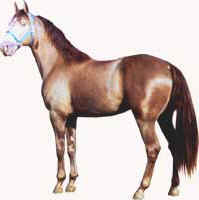 |
| The effect of the
champagne dominant is to dilute black to champagne (sometimes called
lilac dun). Amber champagne is usually the result of the
gene's effect on bay, while gold champagne is associated with the
chestnut color. Palominos can be affected as well and the
results are usually an ivory champagne. Champagne is rather
new and as we deepen our understanding other names will emerge to
describe the horses. |
|
|

|
 |
BLACK |
| The
muzzle, flanks and legs - the entire coat - must be black, with the
exception of white markings. Although the early foal may be an
overall mousy grey, black can usually be determined by the fine
black hair on the muzzle. The coat color darkens to black as the
foal grows older. |
|
|

|
|
ROAN |
The basic coat color (bay, black, chestnut, etc.) of the roan
horse is silvered by a mixture of white hairs, intermingled from
birth with the darker hairs of the base color. Unlike grey horses,
which develop white hairs first on the face, roans show their
basic color on face and lower legs.
Common and colloquial usages of such terms as "strawberry
roan" (roaning on chestnut), "red roan" (roaning on bay), and
"blue roan" (roaning on black) should be amended to the more
precise "chestnut roan, bay roan, or black roan."
The TWHBEA registry requires the combination of base coat
color, such as "black," and the term, "roan" to describe a "black
roan," and not a "blue roan."
|
|
|
Roan silvering is present at birth, in the same proportions that
it will be throughout the horse's life, while the grey foal is
born a solid color and progressively becomes near-white or
completely white in its aging. However, it is possible for a horse
to be both roan and grey.
For example, a black horse which carries both roaning and
greying genes could be born a black roan ... and gradually become
completely white.
|
|
|

|
|
GREY |
| A
mixture of white and dark hairs growing out of a dark skin combine
to mark the coat of a grey TWH. But it is a rare foal born as
a distinct and recognizable grey. Within weeks after being
born a solid base color, they usually will begin showing signs of
grey around the eyes, flank and below the elbow. Grey patches
occasionally will develop on the body, croup, or thigh before they
are visible around the eyes. |
|
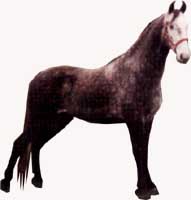 |
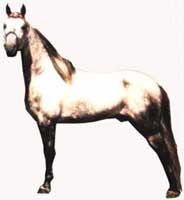 |
|
Genetically, the rule is that the foal will not turn grey unless at
least one parent is grey. A horse may show varying shades of
grey during the greying process. A mixture of white and black
hairs results in a steel grey. Other horses may be rose grey,
a mixture of chestnut and white hairs, or bay grey, made up of bay
and white hairs. Aging causes the coat colors of grey horses
to lighten, sometimes appearing to be white. Dappling is
common and, often, older grey horses grow tufts of reddish brown
hair and are called "flea-bitten." |
|
|
MORE COLORS |
|

|
|
|
|
|

